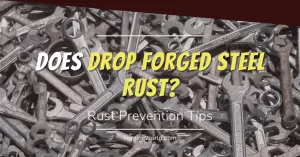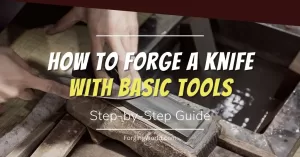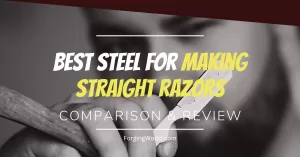Have you ever wondered how expert bladesmiths create those razor-sharp, durable blades that seem to last a lifetime?
Well, buckle up, because today we’re diving into the fantastic world of heat treating and quenching a blade.
This comprehensive guide is perfect for beginners looking to master these essential techniques, so let’s get started!
How to Heat Treat a Knife Blade
Heat treating is a game-changer for your blades, giving them strength, hardness, and flexibility.
This step-by-step guide will walk you through the entire process, from heating your blade to the right temperature to soaking it for the optimal amount of time.
Step 1: Choose the Right Steel
Selecting the right steel for your blade is crucial. Different types of steel require different heat-treating processes.
To help you make the right choice, check out our article on the best knife-making steel for beginners.
Step 2: Preparing Your Forge
Before you begin, make sure your forge is clean and free of debris.
Set up a temperature gauge if you have one, as it will help you monitor and maintain the correct temperature throughout the heat-treating process.
Step 3: Heat Your Blade
Begin heating your forge to the desired temperature. This will vary depending on the type of steel you’re working with, so consult the manufacturer’s guidelines or research the appropriate temperature for your chosen steel.
Tips for Even Heating
- Use a forge with even heat distribution.
- Rotate your blade regularly to ensure consistent heating on all sides.
- Keep an eye on the blade’s color, which will change as it heats. You’re looking for a bright cherry red.
Step 4: Test for Non-Magnetism
As your blade heats, periodically test it with a magnet.
When it reaches a non-magnetic state, it has attained the critical temperature for hardening. This is known as the “Curie point,” and it’s a crucial milestone in the heat treating process.
Step 5: Soaking Your Blade
Once your blade has reached the critical temperature, you’ll need to “soak” it, holding it at this temperature for a specific amount of time. This ensures that the heat penetrates the entire blade, resulting in consistent hardening.
The soaking time will vary depending on the steel’s thickness and composition. As a general rule, soak for at least 5 minutes for every 1/4 inch (6mm) of thickness.
Step 6: Monitoring the Temperature
Throughout the heating and soaking stages, keep a close eye on the temperature. An infrared thermometer can be a valuable tool for this purpose.
If the temperature dips too low, increase the heat. If it gets too high, remove the blade briefly to let it cool slightly before returning it to the forge.
Now that you’ve successfully heat-treated your blade, you’re ready to move on to the quenching process.
How to Quench a Knife Blade
Blade quenching is the process of rapidly cooling your blade after heat treating, locking in the desired properties and creating a harder, more durable blade.
This step-by-step guide will walk you through the quenching process, ensuring that you achieve the perfect cool down for your masterpiece.
Step 1: Choose Your Quenching Liquid
Selecting the right quenching liquid is crucial, as it affects the cooling rate and the final properties of your blade.
Water, oil, and specialized quenching solutions are all viable options, each with their pros and cons. Consult our quenching liquids guide to make an informed choice.
Step 2: Prepare Your Quenching Tank
Set up a quenching tank or container filled with your chosen liquid. The container should be deep and wide enough to fully submerge your blade without touching the sides or bottom.
Additionally, ensure that it’s made of a material that can handle high temperatures without melting or warping.
Step 3: Preheat Your Quenching Liquid
Before quenching, preheat your oil (if using oil) to around 120°F (50°C).
Preheating the oil helps achieve a consistent quench and minimizes the risk of thermal shock, which could cause your blade to warp or crack.
You can use an oil-safe heating element or simply quench a few heated scrap pieces of metal to raise the oil’s temperature.
Step 4: Remove the Blade from the Forge
Once your blade has been properly heat-treated and soaked, carefully remove it from the forge using tongs or other appropriate tools.
Be mindful of the hot blade and avoid any direct contact to prevent burns.
Step 5: Quench Your Blade
Carefully and gently plunge your blade into the quenching liquid, keeping it as vertical as possible.
Move it up and down slightly to promote even cooling and prevent vapor bubbles from forming around the blade.
This movement will ensure that the quenching liquid maintains direct contact with the blade, resulting in a more consistent cooling rate.
Step 6: Monitor the Cooling Process
Keep your blade submerged in the quenching liquid until it reaches room temperature, or at least until it’s cool enough to handle safely. This may take several minutes, depending on the blade’s size and the quenching liquid used.
Step 7: Inspect Your Blade
After quenching, carefully inspect your blade for any signs of warping, cracking, or other defects. If you notice any issues, you may need to reheat the blade, correct the problem, and quench again.
Tempering: The Finishing Touch
Tempering is the final step in the heat treating process. It involves reheating your blade to a lower temperature and then cooling it again.
This process helps reduce brittleness and improve toughness. The ideal tempering temperature depends on the steel and the desired hardness, so be sure to check the manufacturer’s recommendations.
For a detailed guide on tempering, visit our ultimate guide on how to temper a knife.
Common Mistakes and Practical Tips for Heat Treating and Quenching
When heat treating and quenching a blade, it’s crucial to avoid common mistakes that can compromise the quality of your work. Let’s dive into some of these pitfalls and offer practical tips to help you achieve the best results.
Inaccurate Temperature Control
Mistake: Failing to maintain a consistent temperature throughout the heat-treating process can result in uneven hardening and, ultimately, a weaker blade.
Practical Tip: Use a reliable temperature gauge or infrared thermometer to monitor your forge or oven’s temperature. This will help you maintain the correct heat levels for your blade’s specific steel type.
Rushing the Process
Mistake: Skipping or rushing through steps like soaking, tempering, or cooling can lead to an inferior blade with subpar performance.
Practical Tip: Be patient and follow the recommended guidelines for each stage of the heat-treating process. Taking your time will result in a higher-quality blade with optimal properties.
Incorrect Quenching Technique
Mistake: Uneven or aggressive quenching can cause your blade to warp or crack.
Practical Tip: When quenching, keep your blade as vertical as possible and gently move it up and down in the liquid to promote even cooling. Avoid aggressive side-to-side movements, which can result in warping or other damage.
Insufficient Cleaning
Mistake: Failing to clean your blade before heat treating and tempering can result in uneven heat distribution and inaccurate temperature readings.
Practical Tip: Always clean your blade thoroughly before heat treating and tempering. This ensures that the process goes smoothly and results in a high-quality blade.
Overlooking Safety Precautions
Mistake: Neglecting safety measures can lead to injuries and accidents during the heat treating and quenching process.
Practical Tip: Always use proper safety equipment, such as gloves, eye protection, and heat-resistant clothing. Additionally, ensure that your workspace is well-ventilated and free of potential hazards.
For even more helpful information on avoiding common mistakes and improving your knifemaking skills, check out our articles on the 7 most common beginner mistakes in knifemaking and 7 practical knifemaking tips for all beginners. These resources will help you refine your techniques and create stunning, functional blades that you can be proud of.
Frequently Asked Questions
What do you quench a knife blade in?
You can quench a blade in various liquids, with the most common options being water, oil, or specialized quenching solutions. The ideal quenching liquid depends on the blade’s steel type and desired properties.
What is the best quenching liquid for blades?
There is no one-size-fits-all answer, as the best quenching liquid depends on the blade’s steel type and desired properties. Common options include water, oil, and specialized quenching solutions.
Refer to our quenching liquids guide for more information.
How do I know if my blade has reached the proper temperature for heat treating?
Use a temperature gauge or infrared thermometer to monitor the temperature inside your forge or oven. The color of the heated steel can also provide visual cues. For example, a bright cherry-red color typically indicates a temperature range of 1450°F to 1500°F (790°C to 815°C), suitable for many blade steels.
Can I use a regular kitchen oven for tempering?
While not ideal, a kitchen oven can be used for tempering in a pinch. Just be aware that the temperature control might not be as accurate as a specialized heat-treating oven, so monitor the temperature closely and be prepared for potential inconsistencies.
Why is my blade warping during quenching?
Warping can occur due to uneven cooling or aggressive movements during the quenching process. To minimize warping, keep your blade as vertical as possible, move it gently up and down in the quenching liquid, and ensure that it’s fully submerged.
What should I do if my blade cracks during heat treating or quenching?
If your blade cracks, you’ll need to assess the severity of the damage. In some cases, you may be able to repair the blade by grinding away the affected area and re-forging, heat treating, and quenching the blade. If the damage is too severe, you may need to start over with a new piece of steel.
How long should I temper my blade?
Tempering times vary depending on the steel type and desired properties, but a common range is between 1 to 2 hours. Consult the manufacturer’s guidelines or research the appropriate tempering time for your specific steel.
Can I heat treat and quench a blade without specialized equipment?
While specialized equipment such as a temperature-controlled oven or forge is ideal, it’s possible to heat treat and quench a blade using more basic tools. For example, a homemade charcoal or propane forge can be used for heat treating, while a container filled with water or oil can serve as a makeshift quenching tank. Just be prepared for potential inconsistencies and challenges when using non-specialized equipment.
Final Thoughts
Mastering the art of heat treating and quenching is essential for any aspiring blacksmith or knife maker.
By following the step-by-step guides and practical tips provided in this article, you’ll be well on your way to creating strong, durable, and reliable blades that showcase your craftsmanship.
Remember, patience and practice are key when it comes to perfecting your heat treating and quenching techniques.
Don’t be discouraged by any initial setbacks or mistakes; instead, use them as opportunities to learn and grow as a craftsman. Be sure to consult our other resources and guides on Forging World to further expand your knowledge and improve your skills.
Happy forging, and may your blades be sharp, sturdy, and true!




I am an experienced bladesmith and need to mention a couple of things. 1. Used motor oil is not onnly smelly and toxic, it also cools the steel too slowly and often does not give you full hardening.2. canola or vegetable oil is slower quench than real quenching oil, or even untreated light mineral oil. it is fine for small or thin blades but larger ones may only surface harden. 3. Transmission oil at 120 degrees is good for most steel, and horse-drenching oil is also a good quench. You can find that on line or at farm stores . 4. carbon or low alloy Steel may be readily hardened by an *interruptpd quench* into hot water. Dip the hot blade horizonltally inoto the water and pull out as soon as it stops glowing. You can do a hard edge soft back that way. (try to keep the back of te blade below the non magnetice by dipping it as you heat the edge. Then as soon as the edge cools below red, dip the back.so tis heat won’t “auto-temper’ the back.)
Hello Joe.
I looked over the article and decided to split it up to be more specific on the types of liquids for quenching. I made it more clear about not using motor oil to quench and the potential risks involved for others that aren’t aware.
I really appreciate the feedback. Happy forging!